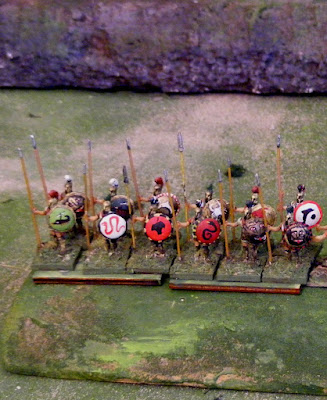The Athenians (Benassi) as seen from behind the Phrygian (Garrison) and Theban position. (The poor Thebans were left with the stragglers when I ran short on hoplites. At some point I need to finish refurbishing the last 48 RAFM hoplite types)
As I look at the table laid out for the refight, a puzzling question comes to mind:
The Pseudo-Spartans (mixed RAFM, Ral Partha, Garrison & Minifig)
from behind the (largely Garrison) Persian center.
from behind the (largely Garrison) Persian center.
Why didn't the Persians outflank and surround the Greeks?
The flanks don't appear to be resting on terrain, there are huge gaps in the middle of the line and lots of cavalry to ride around. The Thessalian cavalry seems to have given a deal of trouble to the Corinthinians and others marching up from the rear so were presumably ordered to ride past them but surely some of the cavalry could have been spared to attack the Athenians and/or Spartans from the rear?
Now I can see in the Dover refight that the lads were probably "in the spirit" and might not have considered such a move to be "on" but what about in the day? There are 3 possible answers that occur to me:
a) Heavily armed hoplites are dangerous to light troops and cavalry even if attacked in rear
b) There were command and control issues at work
c) Some of the Greek light armed troops who appear in the OB but not the battle narrative or the Grant scenario, were employed on rear security.
d) In the Grant scenario, Artabazos's troops start the game with the rest of the army rather than only coming up after the battle was essentially lost. That might substantially affect things.
Well, for the 1st run through, I am going to follow the battle plans in Grant's book as closely as possible so it shouldn't be an issue. I may try alternate versions later.
The Corinthians in position at the foot of the mountain, a lonnnng way from the action.
Rospak hoplites obviously painted while my 1st canine buddy, Yoda the Black Lab was still alive and providing inspiration.
Please click on the pictures to see the full thing if you are only catching the corner.




I like those Rospak hoplite shields, Ross. Nice.
ReplyDelete-- Jeff
Assuming 8 deep and 3' frontage the Greek army is spread over more than 2 miles. Allowing for rises and dips in the ground, plus assorted vegetation, this means that the Persians may not have known where the Greek flanks were, and even if they did the time taken to arrange for troops to outflank them may have been longer than the time taken for the battle to be won/lost anyway.
ReplyDeleteThanks Jeff, my eyes and hands were nearly 30 years younger when I painted them.
ReplyDeleteRob, that may have been true when the whole army was arranged for 12 days but once the various minor states had retreated, followed by the Spartan main body going one way and the Athenians going the other, the gap must have been nearly a mile wide. Granted, the Athenians are said to have been out of view of the Persians but Amonpharetos's division was by itself at first and attacked by a large force of Persian cavalry whom you would expect top flow around it. But perhaps they did and that is a detail just not mentioned, only that the Spartans felt hard pressed.
ReplyDeleteOnce the Spartans had reformed to face the Persians, their line would have only been about 1,000 yards wide. Even if the main body was occupied with a frontal assault surely on the end of the line Persians could see an open flank. Which comes back to command control issues perhaps? or all those light armed troops who aren't mentioned in battle?
-Ross